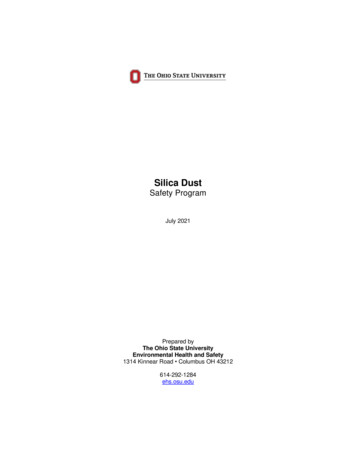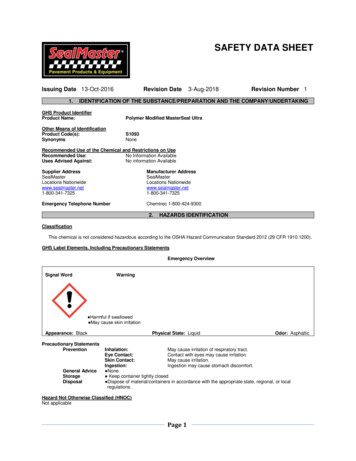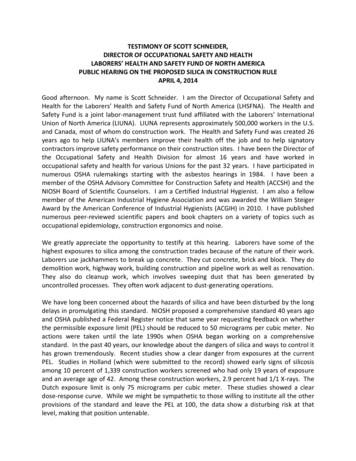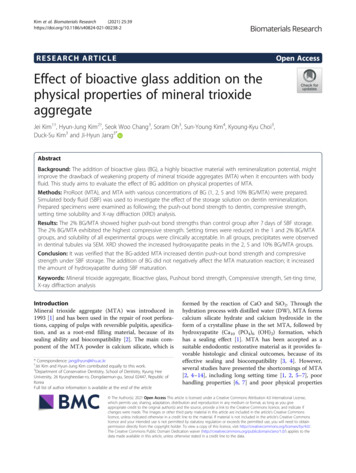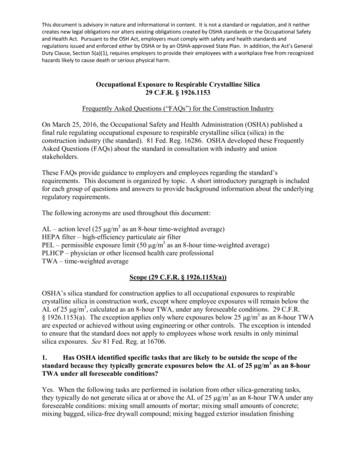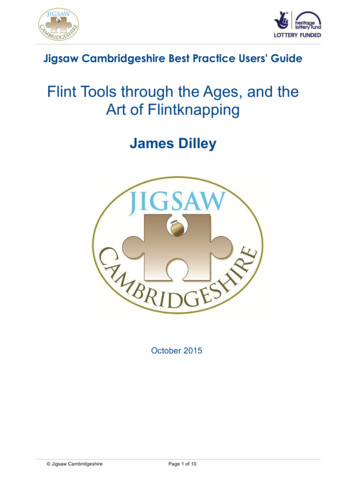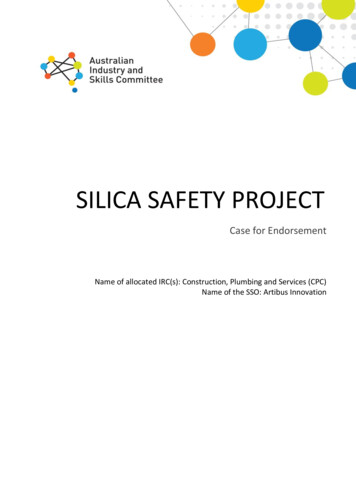
Transcription
SILICA SAFETY PROJECTCase for EndorsementName of allocated IRC(s): Construction, Plumbing and Services (CPC)Name of the SSO: Artibus Innovation
1. Administrative details of the Case for EndorsementRefer to Attachment A for the title and code for each of the training package components that aresubmitted for approval, and an indication of whether these are updated (including equivalence ornon-equivalence status), new or deleted products1.1 Case for Change details1.Artibus/TPD/2020-21/001 Activity Order.2.Approval date: 12 August 2020 (Project 5 – CPC Silica – Skills Forecast).3.AISC approval to develop up to six units of competency on silica safety to address identifiedskill needs.1.2 Timeframes and delaysThe original Activity Order was to be submitted by June 30 2021, but was given an extension to 14March 2022 to provide greater opportunity for consultation and industry input.Progress of the activity has been challenged by several industry issues which have requiredcareful navigation. The issues that have required resolution relate to conflicts of interest and theexistence of an existing nationally registered course 10830NAT Course in Crystalline SilicaExposure Prevention owned by Creative Safety Initiatives Trust. In relation to this course, itsowners raised several concerns:- The potential duplication of training on the National VET Register.- Potential breaches of copyright in relation to its course being used to inform the AustralianIndustry and Skills Committee (AISC) activity.- potential mismanagement of conflicts of interest by the Industry Reference Committee (IRC).All three matters were addressed through multiple rounds of correspondence with the AISC, theAISC Secretariat, the IRC and the Service Skills Organisation (SSO).2. Changes to training products and how these will meet the needs ofindustryRefer to Attachment B for information on how the proposed updates to qualifications will bettersupport job roles in industry.This activity proposes the introduction of four new units of competency to minimise the risk ofrespirable crystalline silica (RCS) in the construction industry.RCS is a known hazard generated when manipulating products and materials containing silica thatcan lead to lung cancer, silicosis, chronic obstructive pulmonary disease and kidney disease. It isestimated that 230 Australians a year will develop lung cancer due to past exposure. This risk ispredominantly born by construction workers, alongside miners, farmers and engineers. Recentyears have seen a notable rise in silica-related illness and death, particularly evident inQueensland and linked to an increase of engineered stone.
It is estimated that in 2011, approximately 587,000 Australians were exposed to silica dust whilstworking, and that 5,758 will eventually develop lung cancer. Workers in engineered stonebenchtop manufacturing, finishing and installation are at particular risk, as this comparativelynew material contains up to 95% crystalline silica, as distinct from natural stone’s crystalline silicacomposition of 5%-50%.The Final Report of the National Dust Disease Taskforce (NDDT) noted that there was a lack ofdust-specific safety training at a national level and that education and training outcomes shouldform part of the roadmap going forward.In recognition of the issue, there has been a rise in jurisdictional and membership-based coursesand government-funded Work Safe and SafeWork awareness campaigns designed to improveeducational and training outcomes around harmful crystalline silica exposure.The Construction IRC has received petitions to develop nationally consistent training productsaround silica safety. For instance, in pages 80-81 of the CPC Construction and Plumbing ServicesIndustry Skills Forecast 2020, there is an example of SafeWork NSW writing to Artibus Innovationin October 2019 requesting that units of competency be developed in the following areas:1. working with silica-containing products2. the development of a general awareness course3. greater emphasis in the Elements and Performance Criteria of relevant units of competency onsilica-containing products.1Other ideas suggested have included developing units of competency at different AQF levelsaround:4. working with silica-containing products5. supervision of people working with silica6. conducting air monitoring of worksites affected by silica dust.The Construction IRC noted that silica safety training should be a sector-wide requirement for thebuilding and construction industry given that anyone entering a worksite is potentially ‘at risk’ ofexposure. It was also agreed that while all construction workers are potentially exposed, thereexists a scale with those most ‘at risk’ including the building and construction occupationsworking closest with products containing the highest levels of crystalline silica (e.g., stonemasonsand others working with engineered and natural stone).The Construction IRC advised that silica awareness training should span the various responsibilitylevels from pre-trades to supervisors and managers. An even more holistic view forwarded wasthat minimising exposure spans the entire supply chain from manufacturing, supplying,installation to demolition.The training products developed in this activity therefore cover:1. awareness of silica exposure, for new entrants and apprentices2. use of respiratory protective equipment3. working with materials and products containing RCS4. supervising work involving methods, materials and products containing RCS.1Artibus Innovation, 2020, Construction and Plumbing Services: Industry Skills Forecast 2020, onstruction Plumbing Services ISF-2020.pdf (accessed 12 Jan. 2021).3
3. Stakeholder consultation strategyRefer to Attachment C for: list of stakeholders that actively participated in consultation on the project summary feedback provided by stakeholder type and the IRCs response to this feedback summary of issues raised during stakeholder consultation and the IRCs response to these issues3.1 Identification of stakeholdersSilica dust exists across a range of products and materials utilised in the building and constructionand other industries such as tunnelling, quarrying and sandblasting. The stakeholder engagementstrategy therefore sought to invite input from a range of sectors. Lists of organisations weresourced from an internet search and recommendations from the IRC resulting in a working groupbeing formed.The NDDT released its report and recommendations during the project and specific engagementwas sought with their contributing organisations. The Department of Health team that oversawthe NDDT was contacted and invited to participate in the development of the units of competency.Some 23 prominent individuals and organisations had made public submissions to the NDDT andthese stakeholders were also approached.SafeWork NSW submitted a request to the IRC outlining the need for training in this area.The Australian Institute of Occupational Hygienists (AIOH) shared news of the review to theirmembership list consisting of around 1000 members as did tool manufacturer Hilti Australia withover 500 connections.Other groups targeted included peak bodies, distributors, fabricators, suppliers, retailers, buildingdevelopers, work health and safety (WHS) assessors, Hebel, stone suppliers and kitchen makers.Stakeholders who had actively participated in finalised projects such as brick and block laying andstonemasonry, demolition and concreting were approached as ‘at risk’ occupations within the CPCConstruction, Plumbing and Services Training Package and invited to comment.Other sectors were also approached, including tunnelling, quarrying, sandblasting, mining, cementand concrete manufacturers, steel fixing, engineering, painting, landscape gardening, architectureand interior design.3.2 Strategies for engaging stakeholdersWorking Group and IRCThe IRC established a working group of recognised experts from WorkSafe, industry andRegistered Training Organisations (RTOs). This group met ten times throughout the projectproviding input on the development of the training products.Each member, under their terms of reference, was encouraged to consult their own networks forinput. This strengthened the technical robustness of the training product and drafting of the unitsof competency. The units of competency were made public on two occasions, for consultation andvalidation. Significant effort was made to ‘let everyone know’ and encourage (and prompt)feedback through 15 newsletter posts, 8 tweets, 15 LinkedIn posts and 6,176 project pages viewson the Artibus Innovation website.Consultation Strategy (7 WEEKS: 11 August – 30 September 2021)4
4,734 individuals, businesses and organisations were invited through the Artibus Innovationnewsletter (on 15 occasions over the life of the project), direct email, working group and IRCnetworks and social media (8 tweets and 15 LinkedIn posts over the life of the project).Four bulletins and promotion of the project web page and feedback tools were made on threeseparate occasions over seven weeks. Over 80 people participated in the survey process.Stakeholders were also invited to make direct submissions to the IRC.41 respondents provided complete survey responses and 7 written submissions were received.Validation Strategy (5 WEEKS: 24 November 2021 – 1 January 2022)Following review and resolution of all the feedback from the consultation round, four draft units ofcompetency were then presented nationally for comment over a five-week duration from 24November 2021 to 1 January 2022.4,761 individuals, businesses and organisations were invited on two separate occasions to providefeedback through the online portal. This included all active stakeholders identified during theconsultation and others that had joined since.A second online briefing was held on 1 December 2021 for which 20 people registered and 14industry stakeholders attended.Response rates were monitored throughout the consultation process. Several rounds of promptingoccurred to elicit responses through various digital channels, email as well as 52 direct phonemeetings with key stakeholders.22 respondents provided complete survey responses and 4 written submissions were received.3.3 Participation by different types of stakeholders1. Stakeholder participation was supported in each state and territory using the state chapters ofMaster Builders Australia, the Construction, Forestry, Maritime, Mining and Energy Union(CFMMEU) and the AIOH.2. In the NT, the Industry Skills Advisory Council NT facilitated consultation and validation withits industry stakeholders.3. Employer and industry with Australia-wide operations were represented on the workinggroup. Working group members facilitated participation by consulting with their state and territory counterparts in major cities and regional areas.4. Remote stakeholders were linked into the project indirectly through discussions with companies which have contracts in the mining and industrial sectors.5. In total, responses were received from every state and territory, in total 189 locations in Australia as shown in the heat map on the following page:5
6
4. Evidence of industry support4.1 Industry support1. The IRC has overseen the training product development and has approved progress at each stage.2. At both consultation and validation, the majority view as well as dissenting views were considered andresolved by the working group and IRC, resulting in a training product that has the support of industry.3. Industry representatives volunteered a significant amount of their time to be involved on the workinggroup (10 meetings). Their willingness to participate reflected their shared commitment to improvingthe nationally available training products and so raise safety for products containing RCS.4. Working group members advised their wider networks to review the newly developed units of competency.5. Experts in developing safer tools and equipment to limit and control airborne silica particles have indicated their support. Consultation with these experts contributed significantly to the development offour new units of competency for the sector.4.2 Engagement of States and Territories1. All State and Territory Training Authorities (STAs) were kept abreast of the project’s progression. STAswere also invited to participate in the webinars and a targeted online meeting at validation stage washeld, at which the project manager provided an overview of the project and was available to answerquestions.2. Representatives from the Department of Training and Workforce Development, WA and the IndustrySkills Advisory Council NT; Victoria’s Curriculum Maintenance Manager participated in online consultation sessions.The State Training Authorities were offered the opportunity to review the Case for Endorsement and agreeto it progressing for endorsement by the AISC. Following are the comments received.STASupportedACTY/NCommentDateSTA OfficerThe ACT will support three of the four units in thecase for endorsement. Based on stakeholderfeedback we will not support the endorsement ofCPCSIL1001 Prepare to work safely with productsand materials containing crystalline silica. Theinclusion of the unit in a Certificate II qualificationwould reach only students in programs that do notrequire an employment contract. There was also theview that the performance criteria could ultimatelycreate a potential risk for both the RTO and thestudent.17/3/22André Diez deAux15/3/22Marilyn NgOn balance the CPCSIL1001 is not fit for purpose inthe ACT training environment.NSWYThe Department has considered the issues raised inthis project by CFMMEU and other stakeholders. Asdocumented in the CfE, the measures taken, andclarification provided to address these issues aresufficient and satisfactory.NSW confirms support for the Case for Endorsement7
- Silica Safety Project.NTYFollowing consultation by ISACNT with a range ofindustry stakeholders it was agreed that there is animportance to have public national trainingstandards available on the National Register.11/3/22NelsonBrowne09/3/22Filippa RossThe NT STA therefore has not objection to the AISCconsidering for approval the CPC Construction,Plumbing and Services Training Package – SilicaSafety Project Case for Endorsement.QldY/NQueensland provides their support to progress to theAISC for consideration except for CPCSIL1001Prepare to work safely with products and materialscontaining crystalline silica proposed unit ofcompetency.Industry stakeholders have a number of concernsaround the assessment arrangements particularlyaround simulated environment, therefore, we believethat more work needs to be done.SAYPlease be advised that based on support from SAstakeholders, SA STA supports this case forendorsement.22/3/22IrinaFeroulevaTASYThanks, and providing any issues raised byTasmanian stakeholders regarding the Silica projectdraft consultation have been addressed, SkillsTasmania has no feedback.9/9/21MichaelMcGeeVICYThe Victorian STA is pleased to support theprogression of the project to the AISC for approvalconsideration.11/3/22JacquiSpencerWAYBased on the materials provided, the WesternAustralian State Training Authority supports theCase for Endorsement for the CPC Construction,Plumbing and Services Training Package Release 8.14/3/22FrancesParnell4.3 Mitigation strategiesFurther information was sought from the ACT and Qld to address their concerns. No further informationhas been received from Qld (as at 23/3/22) and the ACT response follows:1.The inclusion of the unit in a Certificate II qualification would reach only students in programs thatdo not require an employment contract.Artibus Response: Units of competency are standalone and can be imported into any qualification wherethe packing rules allow. For example, an RTO delivering CPC330920 – Certificate III in Bricklaying and8
Blocklaying might reasonably consider that the delivery of CPCSIL1001 Prepare to work safely with products and materials containing crystalline silica is a relevant industry-supported unit of competency to include in their delivery of the qualification.ACT response: All students in the Cert II construction are in programs that do not require an employmentcontract. With the unit as an elective many students may not be exposed to it. As you point out the unit can bepackaged with any qual but the decision rests with the RTO and again as an elective it is unlikely to reacheverybody that requires it.Artibus comment: This applies to every elective unit of competency on the National Training Register andequally to any accredited course.2. There was also the view that the performance criteria could ultimately create a potential risk for both theRTO and the student.Artibus Response: Expert advice: We sought expert advice from the government endorsed quality assurance panel on the inclusion of “slurry”. The panel member who completed the Quality Assurance Reportadvised that the inclusion of slurry supports consistency across Performance Criteria and the PerformanceEvidence. The inclusion of “slurry” was not deemed non-compliant and was considered in line with the intent/scope of the unit.Risk to both RTO and student: ACT had expressed concern that this is a “knowledge” unit of competencyand that the demonstration of practical skills is not required as this may include exposure to Silica. The Assessment Conditions clearly outline the safety requirements necessary to deliver this unit and allows theunit to be delivered in a simulated work environment, where there will be no exposure to silica. This unit,like all other units, is a competency-based unit of competency.Please let me know if I am incorrect in thinking that "slurry" is the issue of concern.ACT Response: As you stated the units can be packaged in any qualification so where the environment is notsimulated but a work exposure, the risk is real.Artibus comment: This applies to every unit of competency delivered on a worksite.4.4 Letters of industry supportLetters of support can be found at Attachment G.9
5. 5. Dissenting views5.1 Dissenting views/issues raisedPotential duplication of training on the National VET RegisterConcerns regarding duplication of training on the National Register was addressed with aresponse to the Construction IRC from Emeritus Professor Tracey Horton AO, Chair of the AISC, on5 July 2021 as follows:Training Packages define the skills and knowledge needed by learners to perform a job.Training Package products are developed when an industry need for training not alreadycovered by a current Training Package is identified. VET accredited courses, in contrast, aredesigned to address skill requirements where these are not covered in nationally endorsedTraining Packages.While an accredited course must not duplicate the outcomes of an endorsed TrainingPackage, there is no policy impediment to the development of national Training Packageproducts which may duplicate accredited courses previously approved by the Australian SkillsQuality Authority (ASQA). Training Package developers should consider copyright issues thatcould arise if a Training Package product reproduces in whole, or a substantial part, thecontent of an accredited course.As with all Training Package projects, the AISC’s key focus in considering the Case forEndorsement arising from the ‘Silica Safety Awareness’ project will be on evidence of industryneed for the proposed training products, and evidence of broad industry support. For moreinformation regarding AISC expectations regarding the Training Package developmentprocess, including regarding stakeholder consultation, please refer to the Training PackageDevelopment and Endorsement Process Policy.Potential breaches of copyright in relation to its course being used to inform the AISC’sactivityConcerns were raised with both the AISC and IRC, by a private training organisation, claiming thatthe newly developed unit of competency, CPCSIL1001 Prepare to work safely with products and materials containing crystalline silica, duplicated a nationally accredited course 10830NAT – Coursein Crystalline Silica Exposure Prevention.AISC responded to the RTO on 25th August 2021 as follows:Thank you for your letter of 7 June 2021 outlining the concerns of Creative Safety Initiativesregarding the development of a silica safety awareness unit of competency for inclusion on theNational Register of VET and the potential duplication with the accredited course 10830NATCourse in Crystalline Silica Exposure Prevention. I understand you have also written to the Australian Skills Quality Authority on this matter. The AISC is committed to ensuring that nationaltraining packages reflect the skills and knowledge required to perform effectively in contemporary job roles, including in relation to operating safely in the workplace. The AISC approved aproject proposed by the Construction, Plumbing and Services Industry Reference Committee(the IRC) to develop nationally consistent training for silica safety awareness given strong evidence of growing skills needs in this area. The AISC sees no policy impediments to the development of an endorsed training package for Silica Safety Awareness.10
The Construction IRC discussed this matter and confirmed that the SSO, the developers of the unitsof competency, had no access to the accredited course and therefore could not have infringed anycopyright issues. The issue was further resolved through correspondence between the AISC secretariat and the SSO.There were a number of other issues raised during the validation stage which were considered bythe working group and reported to the IRC.See Working Group Register of Interests and Attendance record at Attachment I.Management of conflict of interestConcerns were also raised with the AISC relating to the management of perceived and actual conflicts of interest. The IRC, in discussion with the AISC secretariat, put in place tightened processesand procedures to manage this issue in accordance with the operating framework. The AISC notedthe resolution of this matter in correspondence dated 15 August and 19 October 2021 and appropriate registers have been maintained by both the working group and IRC.The AISC Chair’s letter of 5th July 2021 clearly stated “the AISC does require that any cases for endorsement where such conflicts, perceived or actual, exist include documented evidence that theseconflicts have been appropriately managed.” The AISC Chair’s further letter of 18th November2021 again stated that “I request the Case for Endorsement for the silica project should be accompanied by: Evidence documenting how conflict of interest issues were managed for the remainder of theproject, including providing confirmation that conflicted members provided statements advisinghow they would undertake their IRC responsibilities. Thorough records of stakeholder feedback received during the consultations, including veryclear documentation of the IRCs response to this feedback, and a detailed rationale where the IRCdetermines to take a different position to what is advised through the consultation process.”See IRC Conflict of Interest Register at Attachment H.5.2 Rationale for approvalAll stakeholders acknowledge the need to support skills development and minimise the risk ofharm from RCS in the construction industry. The issue is widely recognised as an issue of nationalsignificance requiring a national response.Despite divergent views, the IRC continued to support development of all four units of competencyto ensure that there is a nationally consistent training standard available and accessible to anyRTO that wishes to add the units of competency to their scope and subsequently supportaccessibility to all learners.6. Reports by exceptionN/A11
7. Mandatory Workplace RequirementsRefer to Attachment D for a list of the units of competency, the MWR, the rationale for this, andevidence of employer support for this requirement.There are no mandatory workplace requirements in the four units of competency that comprisethe silica safety project. Assessment of performance can be undertaken in either a workplace or asimulated workplace environment.12
8. 8. Implementation of the new training packages8.1 Implementation issuesThe inclusion of the four new units of competency into the National Register:-does not impact existing STA funding agreements-will coexist with 10830NAT – Course in Crystalline Silica Exposure Prevention privateaccredited course but will offer the training providers an opportunity to have public access tonational silica workplace standards and training delivery.8.2 Potential for traineeship or apprenticeshipsThe introduction of four new standalone units of competency into the National Register on VETcan only be included in a traineeship or an apprenticeship when they are incorporated into aqualification through its packaging rules.During the validation stage, the framework outlined below was put forward to industry to gatherstakeholder feedback on which CPC Construction, Plumbing and Services Training Packagequalifications were best placed to accommodate the inclusion of the silica units of competency.Unit of competencyProposed qualification for unit inclusionCPCSIL1001 Prepare to work safely withproducts and materials containingcrystalline silicaCPC20120 Certificate II in ConstructionCPCSIL2001 Use and maintain respiratoryprotective equipmentCPC32320 Certificate III in StonemasonryCPCSIL3001 Work with products andmaterials containing crystalline silicaCPC32320 Certificate III in StonemasonryCPCSIL4001 Supervise and manage workwith products and materials generatingrespirable crystalline silicaCPC41020 Certificate IV in DemolitionAt its 22 February 2022 meeting, the IRC agreed to include the new silica units of competency aselectives across the qualifications, as per the framework outlined above. The qualifications will bepublished on the National Register via minor release and form part of the CPC Construction,Plumbing and Services Training Package Release 8.0 – Silica Project.8.3 Occupational and licensing requirementsAt the time of publication on the National VET Register, there will be no linkages between theproposed training products and occupational and licensing requirements as the units ofcompetency are new entries to the National Register on VET.At the concluding stages of the project Safe Work Australia released a Code of Practice: Managingthe risks of respirable crystalline silica from engineered stone in the workplace. Whilst the13
CPCSIL3001 Work with products and materials containing crystalline silica unit has been designedto provide support to this Code of Practice, the IRC notes that the specifics of issues related toengineering stone will need further consideration.Victoria has introduced new regulations – Occupational Health and Safety Amendment (CrystallineSilica) Regulations 2021 – which include a requirement for any employer or self-employed personwho works with engineered stone to obtain a licence.NSW has also introduced a Code of Practice – Managing the risks of respirable crystalline silica fromengineered stone in the workplace which commenced on 25th February 2022.8.4 Extension to transition periodWhere the need for an extension to the transition period is identified for training products that arethe subject of this Case for Endorsement, the SSO will apply to the relevant regulator for an extensionto transition, to mitigate the identified impact on other training products, particular student cohortsor industry business needsN/A14
9. Quality AssuranceThe Case for Endorsement meets the following requirements:3.1 Standards for Training Packages 20123.2 Training Package Products Policy3.3 Training Package Development and Endorsement Process Policy3.4 Companion Volume Implementation Guide is available and quality assured. Copies of quality assurance reports are included in Attachment F.10. Implementation of the Minister’s priorities in training packagesRefer to Attachment E for information on no enrolment and low enrolment qualifications reviewedas part of this project, and the outcomes of this review (i.e. product proposed for deletion orretention). Attachment D also includes the rationale for retaining no and/or low enrolment productswhen this is the proposal.Please include an explanation of how approval of the proposed training products will support thereform priorities for training packages agreed by skills ministers in November 2015 and October2020:Streamlining/rationalisation The proposed four new units of competency for the silica safetyof training productsproject, once endorsed, are likely to have widespread applicabilityacross a range of applicable qualifications in the CPC Construction,Plumbing and Services Training Package going forward.A Training Needs Analysis paper was presented to the ConstructionIRC at their meeting on Tuesday, 9 February 2021. The paper wasrequested by the Construction IRC Chair to inform the developmentprocess of the silica safety project. The paper found that there are nostandalone units of competency in the national training system thatexplicitly mention “silica” or “silicosis” from a unit title perspective.While awareness about the dangers posed by silica dust exposurehave been systematically incorporated into the CPC Construction,Plumbing and Services units of competency in recent years, as asimple generalised dot point in the Knowledge Evidence section, thiswas viewed as insufficient for industry given the notable rise in silicarelated illness and deaths in recent years. The paper also identifiedthat although there has been a rise in jurisdictional and membershipbased courses and government-funded awareness campaignsdesigned to improve educational and training outcomes aroundharmful crystalline silica exposure, the national t
The Construction IRC noted that silica safety training should be a sector-wide requirement for the . assessors, Hebel, stone suppliers and kitchen makers. Stakeholders who had actively participated in finalised projects such as brick and block laying and
